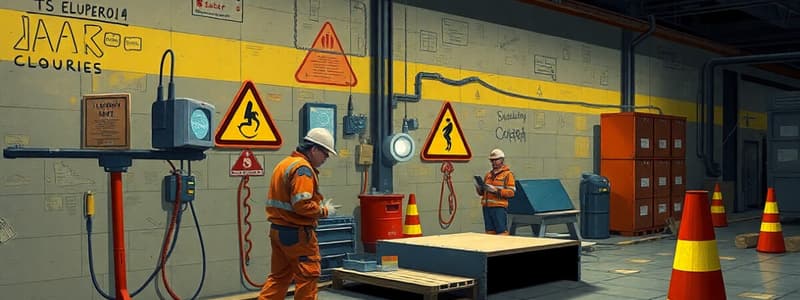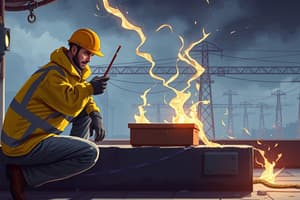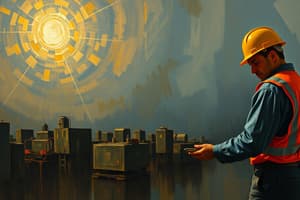Podcast
Questions and Answers
What is the minimum safe distance a worker should maintain from overhead power lines?
What is the minimum safe distance a worker should maintain from overhead power lines?
- 5 ft
- 20 ft
- 15 ft
- 10 ft (correct)
Which type of ladders can be safely used near overhead power lines?
Which type of ladders can be safely used near overhead power lines?
- Plastic ladders
- Metal ladders
- Wood or fiberglass ladders (correct)
- Aluminum ladders
What is the purpose of a power line proximity warning device?
What is the purpose of a power line proximity warning device?
- To lower the boom rapidly
- To insulate the boom from electrical power
- To increase the voltage of the power line
- To notify the operator if the boom is too close to a power line (correct)
What happens as the length of a wire of a given cross-section increases?
What happens as the length of a wire of a given cross-section increases?
What characteristic defines intrinsically safe electrical equipment?
What characteristic defines intrinsically safe electrical equipment?
What should be done when electrical equipment is located in a 'people' zone?
What should be done when electrical equipment is located in a 'people' zone?
What is a common limitation of wire size in electrical applications?
What is a common limitation of wire size in electrical applications?
What is the flash point range for combustible liquids?
What is the flash point range for combustible liquids?
Which class of materials has a flash point less than 100°F?
Which class of materials has a flash point less than 100°F?
What defines a pyrophoric liquid?
What defines a pyrophoric liquid?
Which of the following substances is classified as an oxidizer?
Which of the following substances is classified as an oxidizer?
What is the definition of a poison A?
What is the definition of a poison A?
What is the primary purpose of emergency actions in an incident?
What is the primary purpose of emergency actions in an incident?
What defines an atmospheric tank?
What defines an atmospheric tank?
Which of the following best describes a catastrophic release?
Which of the following best describes a catastrophic release?
What is meant by 'replacement in kind'?
What is meant by 'replacement in kind'?
Which characteristic does a highly hazardous chemical NOT possess?
Which characteristic does a highly hazardous chemical NOT possess?
Which of the following teams may be required during emergency actions?
Which of the following teams may be required during emergency actions?
What does 'normally unoccupied remote facility' refer to?
What does 'normally unoccupied remote facility' refer to?
What is a trade secret?
What is a trade secret?
What is the purpose of using personal protective equipment (PPE)?
What is the purpose of using personal protective equipment (PPE)?
What actions can emergency actions include?
What actions can emergency actions include?
What is the maximum distance for grounding protection over 500V?
What is the maximum distance for grounding protection over 500V?
Which of the following is a common effect of electrical hazards?
Which of the following is a common effect of electrical hazards?
What voltage is considered low-voltage equipment?
What voltage is considered low-voltage equipment?
What property of a material is capacitance measured in?
What property of a material is capacitance measured in?
How much energy in joules does a spark from static electricity release when a person walks on carpet?
How much energy in joules does a spark from static electricity release when a person walks on carpet?
What is a primary function of Smart Power Integrated Circuits (PIC)?
What is a primary function of Smart Power Integrated Circuits (PIC)?
Which of the following can produce static electricity?
Which of the following can produce static electricity?
What is the approximate capacitance for a person in farads?
What is the approximate capacitance for a person in farads?
What minimizes the buildup of static charge in an environment?
What minimizes the buildup of static charge in an environment?
What is the primary cause of fatigue failure in materials?
What is the primary cause of fatigue failure in materials?
Which factor contributes to creep in materials?
Which factor contributes to creep in materials?
What is the role of moisture in the corrosion of buried LPG pipework?
What is the role of moisture in the corrosion of buried LPG pipework?
What is tuberculation in the context of pipeline corrosion?
What is tuberculation in the context of pipeline corrosion?
Which method is NOT effective for protecting against corrosion?
Which method is NOT effective for protecting against corrosion?
What are corrosion cells primarily concerned with?
What are corrosion cells primarily concerned with?
What is the consequence of poor or faulty workmanship in structural design?
What is the consequence of poor or faulty workmanship in structural design?
What causes the area of high stress concentration in materials?
What causes the area of high stress concentration in materials?
What is a potential result of inadequate support in a structure?
What is a potential result of inadequate support in a structure?
What is the impact of cyclical loading on material fatigue?
What is the impact of cyclical loading on material fatigue?
Flashcards
Overhead Power Lines
Overhead Power Lines
Overhead power lines are not typically insulated, meaning they carry electrical current without a protective covering. This makes them potentially dangerous, and safety precautions must be taken.
Power Line Boundaries
Power Line Boundaries
Demarcating boundaries around energized power lines is crucial for safety. These boundaries can be defined by flags, warning devices, or designated work zones, and they prevent workers from getting too close to the lines.
Work Zone Around Power Lines
Work Zone Around Power Lines
A work zone around energized power lines is defined as the area 360 degrees around the equipment. This area must be kept clear of workers and other equipment.
Power Line Distance
Power Line Distance
Signup and view all the flashcards
Crane Insulation
Crane Insulation
Signup and view all the flashcards
Limit Switches
Limit Switches
Signup and view all the flashcards
Wire Length and Resistance
Wire Length and Resistance
Signup and view all the flashcards
Double Insulation (Class II)
Double Insulation (Class II)
Signup and view all the flashcards
Low-Voltage Equipment
Low-Voltage Equipment
Signup and view all the flashcards
Safe Distance for High Voltage
Safe Distance for High Voltage
Signup and view all the flashcards
Cardiopulmonary Resuscitation (CPR)
Cardiopulmonary Resuscitation (CPR)
Signup and view all the flashcards
Smart Power Integrated Circuits (PICs)
Smart Power Integrated Circuits (PICs)
Signup and view all the flashcards
Static Electricity
Static Electricity
Signup and view all the flashcards
Static Electricity Spark Discharge
Static Electricity Spark Discharge
Signup and view all the flashcards
Static Electricity Controls
Static Electricity Controls
Signup and view all the flashcards
Capacitance
Capacitance
Signup and view all the flashcards
Atmospheric Tank
Atmospheric Tank
Signup and view all the flashcards
Boiling Point (14.7 PSI)
Boiling Point (14.7 PSI)
Signup and view all the flashcards
Catastrophic Release
Catastrophic Release
Signup and view all the flashcards
Highly Hazardous Chemical
Highly Hazardous Chemical
Signup and view all the flashcards
Normally Unoccupied Remote Facility
Normally Unoccupied Remote Facility
Signup and view all the flashcards
Process (Hazardous Chemicals)
Process (Hazardous Chemicals)
Signup and view all the flashcards
Replacement in Kind
Replacement in Kind
Signup and view all the flashcards
Trade Secret
Trade Secret
Signup and view all the flashcards
Emergency Actions
Emergency Actions
Signup and view all the flashcards
Cleanup Areas, Locker Rooms, and Showers
Cleanup Areas, Locker Rooms, and Showers
Signup and view all the flashcards
Plasticity
Plasticity
Signup and view all the flashcards
Cold Work Hardening
Cold Work Hardening
Signup and view all the flashcards
Fatigue Failure
Fatigue Failure
Signup and view all the flashcards
Beachmarks
Beachmarks
Signup and view all the flashcards
Creep
Creep
Signup and view all the flashcards
Corrosion
Corrosion
Signup and view all the flashcards
Tuberculation
Tuberculation
Signup and view all the flashcards
Protective Coating
Protective Coating
Signup and view all the flashcards
Sacrificial Anode
Sacrificial Anode
Signup and view all the flashcards
Overloading
Overloading
Signup and view all the flashcards
Pyroforic Liquid
Pyroforic Liquid
Signup and view all the flashcards
Flammable Liquid
Flammable Liquid
Signup and view all the flashcards
Flammable Solid
Flammable Solid
Signup and view all the flashcards
Corrosive Material
Corrosive Material
Signup and view all the flashcards
Oxidizer
Oxidizer
Signup and view all the flashcards
Study Notes
Electrical Basics
- Voltage is the difference in charge between two points
- Current is the rate at which charge flows
- Resistance is a material's tendency to resist current flow
Ohm's Law
- V = I x R, where V is voltage (volts), I is current (amperes), and R is resistance (ohms)
- 1 Ampere = 1 Coulomb
Series Circuits
- Components are connected along a single path.
- The same current flows through all components
Parallel Circuits
- Electrical current to each element is separate.
- If one element fails, others still function.
Direct Current (DC)
- Unidirectional flow of electric charge
- Current flows in the same direction constantly
Alternating Current (AC)
- Electric charge periodically reverses direction.
- Current values periodically change between positive and negative values.
Resistance in a Series Circuit
- Rseries = R1 + R2 + ... + Rn
Resistance in a Parallel Circuit
- 1/Rt = 1/R1 + 1/R2 + ... + 1/Rn
Voltage in AC Circuits
- V = √(P/cosФ) where V is voltage, P is true power, and Ф is the phase angle in degrees.
Power in DC Circuits
- P = VI
- P =I²R
- P = V²/R where P is power (watts), V is voltage (volts), and I is current (amperes), and R is resistance (ohms)
Power in AC Circuits
- P = V I cosФ.
Joule's Law
- P = I²R = IV = V²/R
- where 'P' is electrical power (watts), 'I' is current (amperes), 'V' is voltage (volts), and 'R' is resistance (Ω)
Capacitors/condensers
- Passive components with two conductors separated by a dielectric.
- Store energy in the electric field.
- Measured in farads (F).
Capacitance in a Series Circuit
- 1/Ct = 1/C1 + 1/C2 + ... + 1/Cn
Capacitance in a Parallel Circuit
- Cparallel = C1 + C2 + ... + Cn
Oscillators
- Electronic circuits producing high-frequency alternating currents
Thermocouples
- Sensors measuring temperature, converting heat into electrical energy
Inductors
- Passive components storing energy in a magnetic field.
- Measured in henries (H).
Electrical Shock Hazard
- Severity of injury depends on the electric current's magnitude and duration, body resistance, and the current path through the body.
- 5 mA: Slight shock, not painful
- 6-25 mA: Painful shock, loss of muscular control
- 50-150 mA: Freezing current (cannot let go), life threatening
Studying That Suits You
Use AI to generate personalized quizzes and flashcards to suit your learning preferences.




